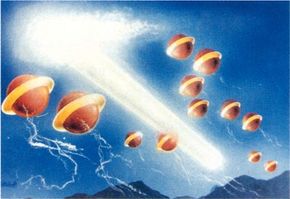It was the strangest sight to ever grace the sky over Oloron, France. In the early afternoon of October 17, 1952, according to one of the many witnesses, high school superintendent Jean-Yves Prigent, there appeared a "cottony cloud of strange shape. . . . Above it, a narrow cylinder, apparently inclined at a 45-degree angle, was slowly moving in a straight line toward the southwest. . . . A sort of plume of white smoke was escaping from its upper end."
In front of this "cylinder" were 30 smaller objects that, when viewed through opera glasses, proved to be red spheres, each surrounded by a yellow ring. "These 'saucers' moved in pairs," Prigent said, "following a broken path characterized in general by rapid and short zigzags. When two saucers drew away from one another, a whitish streak, like an electric arc, was produced between them."
Advertisement
But this was only the beginning of the strangeness. A white, hairlike substance rained down from all of the objects, wrapping itself around telephone wires, tree branches, and the roofs of houses. When observers picked up the material and rolled it into a ball, it turned into a gelatinlike substance and vanished. One man, who had observed the episode from a bridge, claimed the material fell on him, and he was able to extract himself from it only by cutting his way clear-at which point the material collected itself and ascended.
A nearly identical series of events occurred in Gaillac, France, ten days later.
Such "angel hair" is reported from time to time. Laboratory analysis of authentic material (airborne cobwebs are sometimes mistaken for angel hair) is impossible because the material always vanishes. In the summer of 1957, when Craig Phillips (director of the National Aquarium from 1976 to 1981) witnessed a fall off the Florida coast, he collected samples and placed them in sealed jars. But by the time he got to his laboratory, they were gone.
Advertisement
